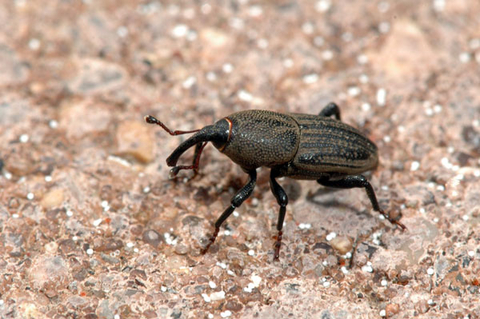Quick facts
- Bluegrass billbug (Sphenophorous parvulus) is a beetle, belonging to the family Curculionidae.
- It is a root-feeding insect found on lawns and turf grass.
- Billbugs can be seen near sidewalks, driveways and other sources of heat.
- Damage is most commonly seen during July and August.
- Signs of damage are: small irregular patches on the lawn that are yellow, brown or straw-colored.
- Billbugs are best controlled in May as the females are laying eggs.
How to identify bluegrass billbugs
Billbugs are most active in spring and late summer.
- Adult billbugs are 1/4-inch long, gray-to-black beetles with a long snout and a strongly tapered abdomen.
- They are seen walking on hard surfaces in spring before they deposit eggs in grass sheaths.
- Plump, legless white larvae emerge from the eggs and feed first inside stems and then on roots.
- Larvae complete feeding in late July. Then, they emerge as adults in August to overwinter in protected locations.
Damage caused by bluegrass billbugs
Bluegrass billbug damage causes discolored, irregularly shaped areas of grass that become yellow and finally turn brown.
These insects live inside the grass sheath and do not separate blades from the roots until the last larval stage.
Turf can be pulled out easily because of weakened roots in areas with serious damage.
How to protect your lawn from bluegrass billbugs
Watering and moderate fertilization of grass will help reduce the damage caused by billbugs. You may not need to apply pesticides if the grass is generally healthy.
Check for larvae by inspecting a square-foot sample of lawn.
Start looking along the margin where dead or damaged grass meets healthy grass.
Apply pesticide 10 days after adult billbugs are seen on the grass.
- Imidacloprid acts slowly in the soil but is effective in controlling billbugs.
- For best results, thoroughly water the lawn immediately after treatment.
- Trichlorfon is a faster-acting pesticide.
- Halofenozide is an insect growth regulator (IGR) that impacts the insect molting process.
Do not apply pesticide after mid-July because the larvae complete their feeding and move 1 to 2 inches into the soil to transform into pupae.
CAUTION: Mention of a pesticide or use of a pesticide label is for educational purposes only. Always follow the pesticide label directions attached to the pesticide container you are using. Remember, the label is the law.
Reviewed in 2024




